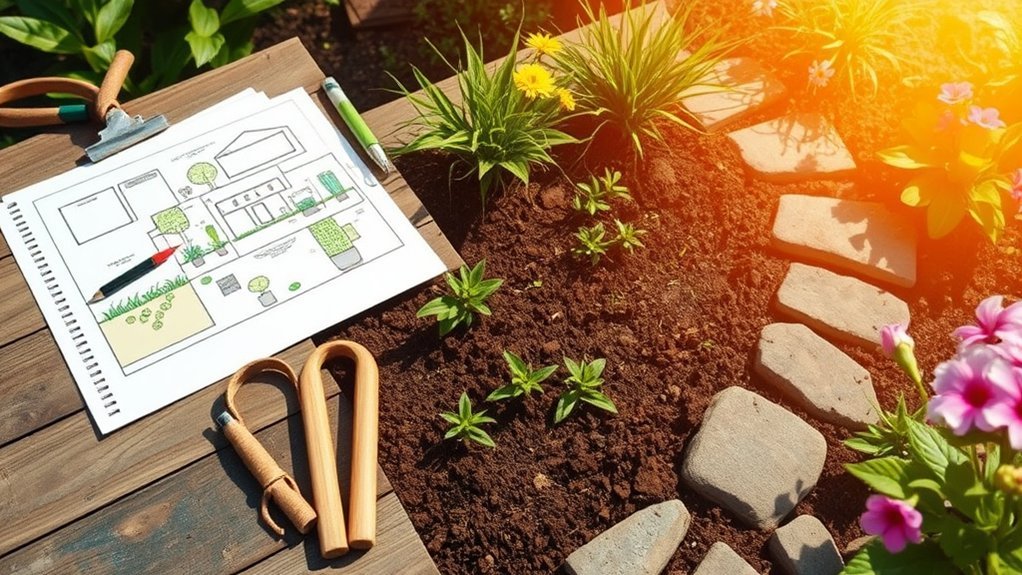Hey, wanna create your own DIY home landscaping project? It? s easier than you think! First, measure your yard and map it out on graph paper. Next, sketch some design ideas, like a cool focal point. Then, play with layout options for plants and paths. After that, finalize your plan with balance in mind. Last, define symbols for trees and flowers. Stick around, and you? ll uncover even more handy tips for your project!
Key Takeaways
- Measure your yard and create a scaled map on graph paper for accurate planning.
- Sketch initial design ideas using tracing paper over your base map.
- Experiment with different layouts to optimize plant placement and pathways.
- Finalize your plan focusing on unity, balance, and practical considerations like drainage.
- Define clear symbols for elements like trees and pathways for implementation.
Measure and Map Your Yard
Hey there, let? s kick off your DIY landscaping adventure with an essential step: measuring and mapping your yard. Grab a tape measure, and jot down the measurements of your space, including the house, trees, and walkways. Use graph paper to scale it all out, making each square equal a foot for accuracy.
Wondering why this matters? A solid landscape layout starts here, helping you see the big picture. Add a compass rose to track sunlight direction, since it? s key for plant selection later. Note slopes or drainage spots too, as they? ll shape your plans. For a unique twist, consider coastal landscaping styles to bring a breezy, seaside vibe to your outdoor space.
Ever tried fitting puzzle pieces together? That? s your yard map? every detail counts. So, get measuring, and let? s build that perfect outdoor space! For inspiration, explore budget-friendly landscaping ideas to transform your yard without breaking the bank.
Sketch Initial Design Ideas
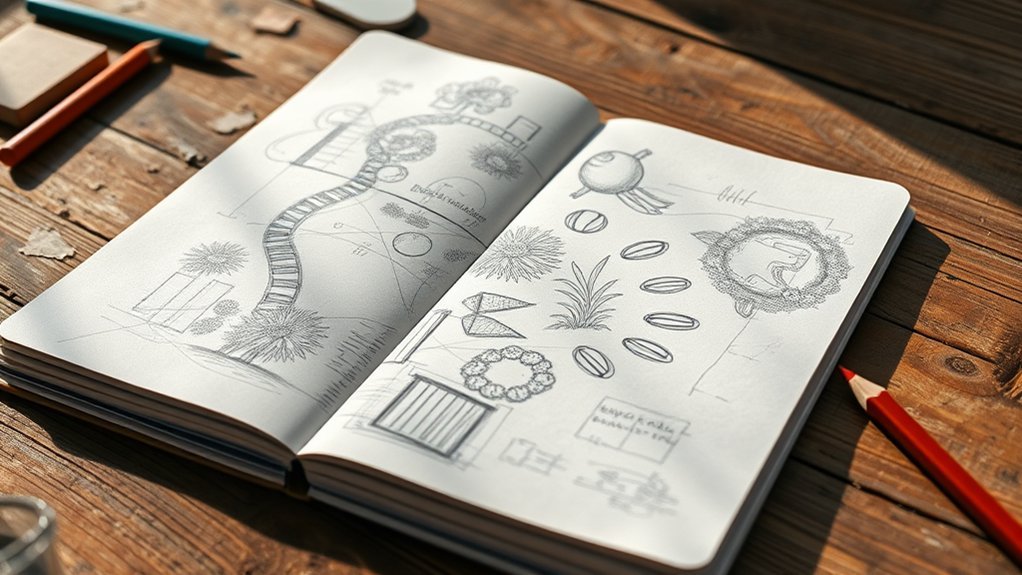
Imagination is your best tool as you plunge into sketching initial design ideas for your yard. Grab some tracing paper, lay it over your property map, and start doodling your landscape design. Think about a cool focal point, like a funky statue or tree, to draw the eye. What catches your attention first?
Next, use scale on graph paper to keep things real? match your yard? s actual size. Sketch pathways, beds, and smaller plants for balance, using colors or symbols to show what? s what.
Ever tried drawing a map like a treasure hunt? Keep it simple, mark hardscape and softscape, and play with ideas. How do you want your space to look? Let? s get those creative juices flowing!
Experiment With Layout Options
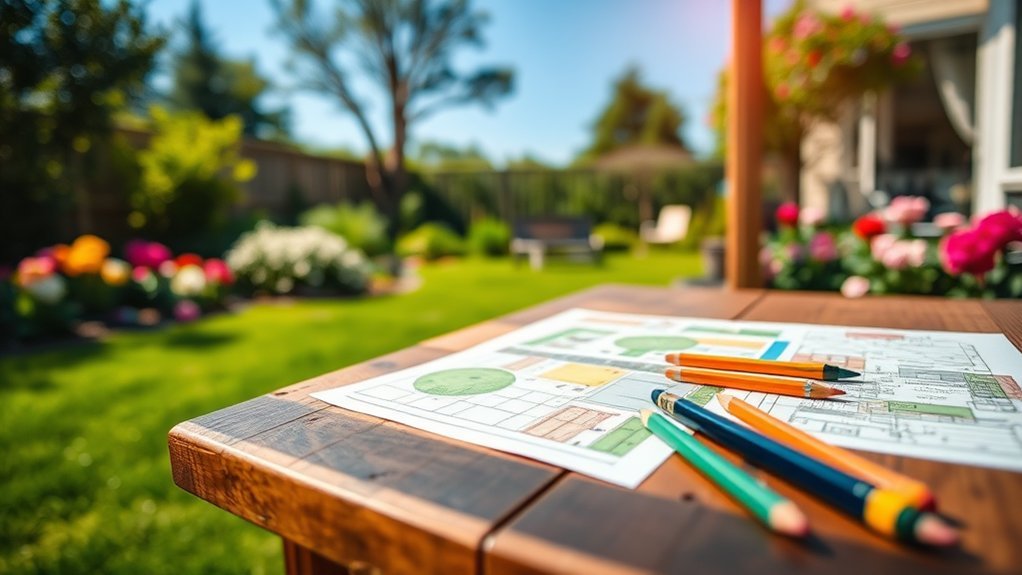
Now that you? ve sketched some initial ideas, let? s play around with different layout options.
Grab some tracing paper, lay it over your base plan, and experiment with layout options like plant arrangements. Try different spots for flowers and shrubs, seeing what looks best. How about pathways and garden structures? Sketch various routes to make sure wheelbarrows can roll through easily.
Also, think about sun patterns and shade areas when placing plants; some need lots of light, others don? t. Mix things up by layering plant heights for depth, like stacking blocks in a game.
Test multiple sketches to see how layouts flow. What works for your yard? s vibe? Keep tweaking until the design clicks for you.
Finalize Your Landscape Plan
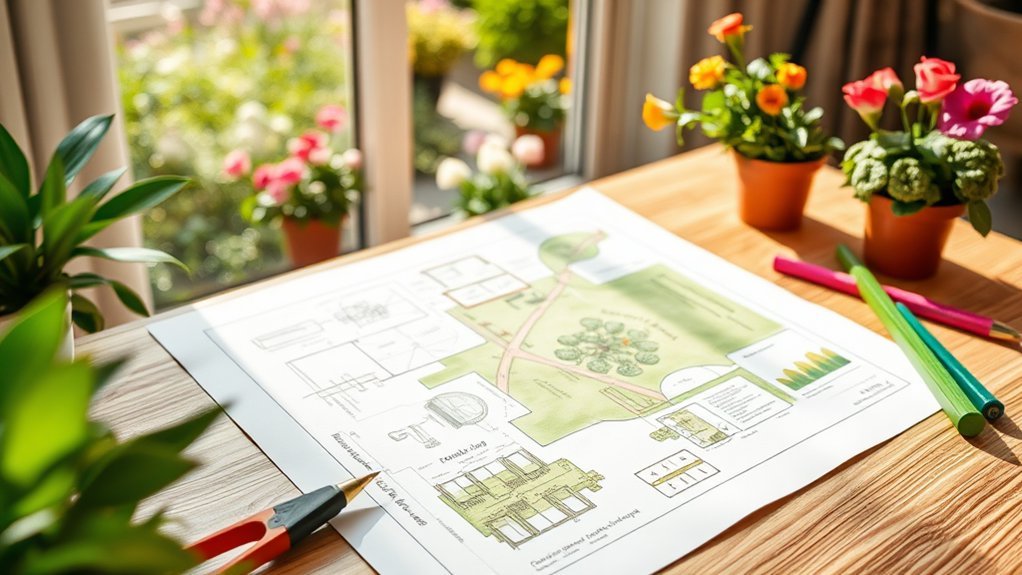
After experimenting with layouts, it? s time to lock in your landscape plan. You? ve got ideas, now finalize your landscape plan with care.
Focus on design principles like unity and balance, ensuring everything fits together nicely. Check your front yard layout? does it look good and work well? Make sure traffic flow is smooth, so you can move around easily for maintenance.
Prioritize unity and balance in your design, ensuring a cohesive front yard. Confirm smooth traffic flow for easy maintenance access.
Next, nail down your plant selections by picking ones that won? t outgrow their spots. Think about their size compared to your house, okay?
Review your plan a few times to confirm it matches your vision. Does it handle practical stuff like privacy or drainage? Trust me, it? s like piecing a puzzle? every bit needs to fit just right.
Define Symbols for Implementation
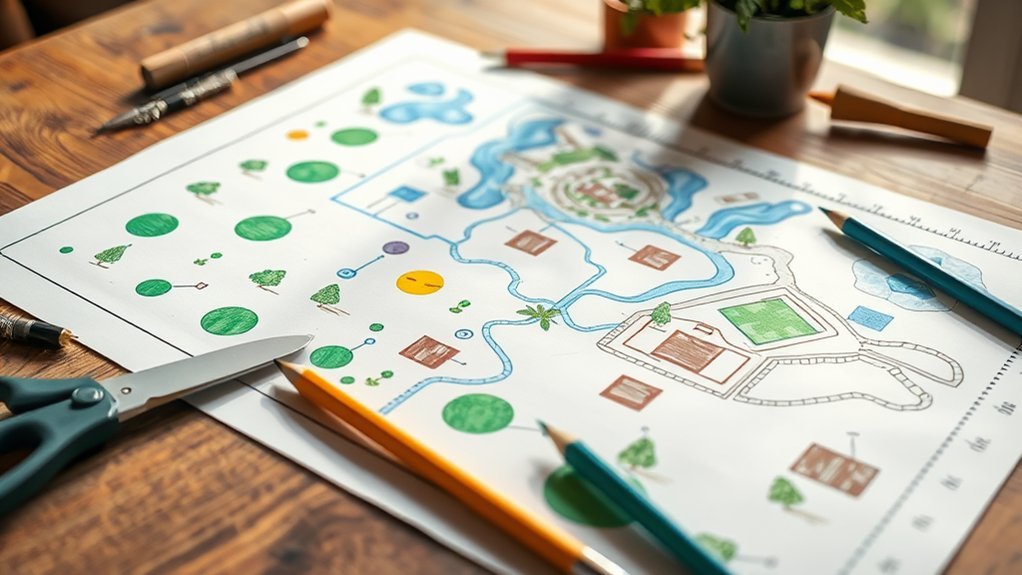
Let’s move from finalizing your landscape plan to setting up clear symbols for the next steps.
As you plan a landscape, symbols help show what goes where, making certain everyone, even if you’re not a pro landscape designer, gets the idea. They? re like a secret code, so consistency is key for clear communication.
Wondering what symbols to use? Check out these easy examples:
- Zigzag lines for brick patterns, mimicking a cool design.
- Circles or ovals for trees and shrubs, showing where greenery grows.
- Small squares for flower beds, marking spots for colorful blooms.
Double-check your symbols on the final draft, okay?
Verify they? re placed right, so your vision comes to life without any mix-ups during implementation.
Frequently Asked Questions
What Are the 7 Steps to Landscape Design?
Hey, wanna master landscape design? Start with site analysis, then plunge into plant selection. Use design software for precision, prioritize budget planning, and don? t skip maintenance considerations. Keep tweaking until it? s perfect!
What Are the 5 Basic Elements of Landscape Design?
Hey, you? ve gotta know the 5 basic elements of landscape design: line, form, texture, color, and scale. Use plant selection tips, color harmony strategies, texture variety importance, functionality considerations, and seasonal changes impact.
What Is the Rule of 3 in Landscaping?
Hey, you? ve gotta know the Rule of 3 in landscaping! Group elements in threes for landscape balance and visual interest. Use plant grouping, design harmony, and spatial arrangement to create a stunning yard.
What Is the First Step When Starting a Landscape Design for a Home?
Hey, let? s plunge into crafting your outdoor masterpiece! Start your landscaping inspiration by listing your dream features. Use design software, conduct site analysis, finalize plant selection, and nail down cost estimation right away.
Conclusion
Hey, you? ve got this landscaping thing down now, right? With these five steps, you? re set to turn your yard into a masterpiece, like painting on a giant canvas. So, what? s stopping you from grabbing that shovel? Measure, sketch, experiment, finalize, and define those symbols. It? s all in your hands, isn? t it? Get out there, start digging, and watch your ideas grow. Ready to make your dream yard real today?

